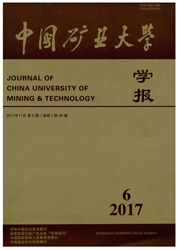

 中文摘要:
中文摘要:
将底板剩余完整岩层带内强度较高的单一薄岩层或含软弱夹层且相距较近的两层薄坚硬岩层构成的复合岩层简化为四边固支的矩形薄板,建立了底板复合隔水关键层力学模型,推导了其突水力学判据.通过引入强度特性及尺寸效应参数,分析了复合隔水关键层的厚度、层位、长宽及内聚力、内摩擦角对其隔水性能的影响.结果表明:底板复合隔水关键层所能承受的最大递进导升水压与其厚度成二次抛物线关系,厚度越大,隔水性能越好;底板复合隔水关键层位于底板剩余完整岩层带下部时,更有利于阻隔底板突水;底板复合隔水关键层所能承受的最大递进导升水压随工作面推进距离的增大而减小,随工作面长度的增大而减小,适当控制工作面长度有利于控制底板突水.
 英文摘要:
英文摘要:
We regarded the thick single rock stratum with higher strength or thick hard compound rock strata of two-layer with certain weak intercalation and short distance in remaining complete strata of mining floor as clamped rectangular thick plate.A mechanical model for the compound water-isolation key strata of floor was developed as well as the mechanical criterion of water-inrush from floor.By introducing the strength characteristics and size effect parameters,this paper analyzed the influence of thickness,location and dimension of the compound water-isolation key strata and its cohesive strength and internal friction angle on the water-isolating capacity.The results indicate that a parabola relationship exists between the maximum progressive water pressure that the thickness of the compound water-resisting key strata,the greater the thickness,the better the water-isolating capacity;the compound water-resisting key strata located within the undisturbed floor strata offers better protection from floor water-inrush.The maximum progressive water pressure that the compound water-resisting key strata can tolerate decreases with face advance distance and face width.The prevention of water-inrush from floor can be achieved by the proper selection of face width.
 同期刊论文项目
同期刊论文项目
 同项目期刊论文
同项目期刊论文
 期刊信息
期刊信息
